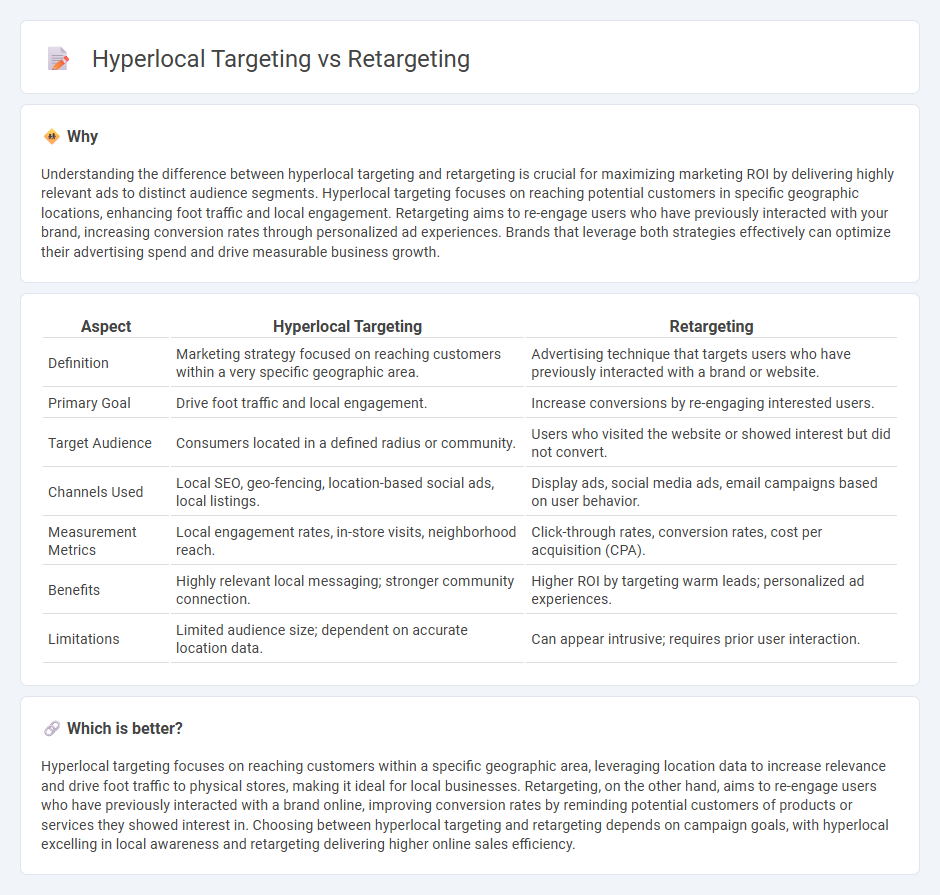
Hyperlocal targeting focuses on reaching potential customers within a very specific geographic area, enhancing local engagement and driving store visits with personalized offers. Retargeting targets users who have previously interacted with a brand's website or app, aiming to convert interest into sales through tailored ads across multiple platforms. Discover the distinct benefits and strategies behind hyperlocal targeting and retargeting to optimize your marketing campaigns.
Why it is important
Understanding the difference between hyperlocal targeting and retargeting is crucial for maximizing marketing ROI by delivering highly relevant ads to distinct audience segments. Hyperlocal targeting focuses on reaching potential customers in specific geographic locations, enhancing foot traffic and local engagement. Retargeting aims to re-engage users who have previously interacted with your brand, increasing conversion rates through personalized ad experiences. Brands that leverage both strategies effectively can optimize their advertising spend and drive measurable business growth.
Comparison Table
| Aspect | Hyperlocal Targeting | Retargeting |
|---|---|---|
| Definition | Marketing strategy focused on reaching customers within a very specific geographic area. | Advertising technique that targets users who have previously interacted with a brand or website. |
| Primary Goal | Drive foot traffic and local engagement. | Increase conversions by re-engaging interested users. |
| Target Audience | Consumers located in a defined radius or community. | Users who visited the website or showed interest but did not convert. |
| Channels Used | Local SEO, geo-fencing, location-based social ads, local listings. | Display ads, social media ads, email campaigns based on user behavior. |
| Measurement Metrics | Local engagement rates, in-store visits, neighborhood reach. | Click-through rates, conversion rates, cost per acquisition (CPA). |
| Benefits | Highly relevant local messaging; stronger community connection. | Higher ROI by targeting warm leads; personalized ad experiences. |
| Limitations | Limited audience size; dependent on accurate location data. | Can appear intrusive; requires prior user interaction. |
Which is better?
Hyperlocal targeting focuses on reaching customers within a specific geographic area, leveraging location data to increase relevance and drive foot traffic to physical stores, making it ideal for local businesses. Retargeting, on the other hand, aims to re-engage users who have previously interacted with a brand online, improving conversion rates by reminding potential customers of products or services they showed interest in. Choosing between hyperlocal targeting and retargeting depends on campaign goals, with hyperlocal excelling in local awareness and retargeting delivering higher online sales efficiency.
Connection
Hyperlocal targeting and retargeting are interconnected strategies that enhance marketing precision by focusing on users within a specific geographic area and re-engaging those who have previously interacted with a brand. Hyperlocal targeting leverages geofencing and location-based data to deliver relevant ads to audiences in a narrow radius, while retargeting uses cookies and user behavior data to serve personalized ads that encourage conversion. Combining these approaches increases ad relevance, improves engagement rates, and drives higher ROI by addressing potential customers at the right place and time with tailored content.
Key Terms
Audience Segmentation
Retargeting targets users based on prior interactions with a brand, focusing on personalized ads to re-engage interested audience segments. Hyperlocal targeting narrows audience segmentation to specific geographic locations, delivering tailored ads relevant to users within a precise area, such as neighborhoods or zip codes. Explore more about how combining audience segmentation strategies can optimize your digital marketing campaigns.
Geofencing
Geofencing harnesses location-based technology to create virtual boundaries, allowing hyperlocal targeting to deliver personalized ads within a specific geographic area, enhancing relevance and engagement. Retargeting, on the other hand, uses user behavior data to serve ads to individuals who have previously interacted with a brand, regardless of their location, optimizing conversion rates by maintaining brand awareness. Discover the nuances between geofencing-driven hyperlocal targeting and behavior-based retargeting to maximize your advertising strategy.
Conversion Optimization
Retargeting targets users who have previously interacted with a brand, leveraging behavioral data to increase conversion rates by reminding potential customers of abandoned carts or viewed products. Hyperlocal targeting narrows the audience to a specific geographic area, enhancing conversion optimization by delivering personalized ads tailored to local preferences and immediate needs. Explore advanced strategies and tools to maximize your conversion optimization with retargeting and hyperlocal targeting techniques.
Source and External Links
What Is Retargeting? How To Set Up an Ad Retargeting Campaign - This guide explains retargeting as a digital marketing strategy designed to re-engage potential customers who have shown interest in a brand but haven't converted.
Retargeting: Definition, Types and How-tos - This resource provides an overview of retargeting as a tactic to serve ads based on users' prior engagement with a brand, helping to re-engage potential customers.
What is Ad Retargeting? - This article describes retargeting as a method to bring back website visitors who didn't convert by showing them relevant ads on other websites.
 dowidth.com
dowidth.com